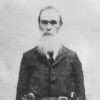calsfoundation@cals.org
First Arkansas Light Artillery Battery (US)
The First Arkansas Light Artillery Battery was a military unit organized from Arkansas Unionists during the Civil War. The battery served in Arkansas, Missouri, and the Indian Territory.
The battery was the first artillery unit raised by Federal forces in the state. Denton Stark, the adjutant of the First Arkansas Cavalry, received permission to raise the unit in January 1863. Recruiting began immediately, and men from Benton, Washington, Madison, Crawford, Sebastian, Franklin, Johnson, and Sevier counties joined the battery. It reached full strength of 110 men by April 1 and began active service in Fayetteville (Washington County). Stark became the first commander of the battery. Although the battery was an artillery unit, it was not armed at this time and lacked basic military equipment and horses. Colonel Marcus LaRue Harrison, commander of the Federal garrison in Fayetteville, repeatedly requested arms and equipment for the battery and other units under his command. By June, the battery was placed in a brigade under the command of Colonel John Edwards based in Springfield, Missouri. This assignment changed the next month when the battery moved to a brigade commanded by Major Hugh Campbell.
The battery received arms and equipment at an unknown date in Springfield and joined active operations in northwestern Arkansas and southwestern Missouri. Armed with six guns organized into three sections, the battery often operated with the First Arkansas Cavalry in expeditions to find Confederate forces and guerrilla bands. The battery lost its first soldier to enemy action on June 15, 1863, near Warsaw, Missouri.
The battery moved to Fayetteville on September 21, 1863, and served as part of the Federal garrison. In late October, part of the battery participated in a skirmish at Cross Timbers, Missouri. On March 19, 1864, the battery was ordered to Fort Smith (Sebastian County), where it joined the Frontier Division under the command of Brigadier General John Thayer. The battery was placed into a brigade under the command of Colonel Charles Adams. The brigade consisted of the battery, the Twelfth Kansas Infantry, and the First and Second Kansas Colored Infantries. The division moved toward Arkadelphia (Clark County), where it was to join another Union force under the command of Major General Frederick Steele. The combined force was to work in conjunction with an army moving up the Red River in Louisiana to capture Shreveport and invade Texas. Only two sections with a total of four guns moved with the division. The third section remained in northern Arkansas.
The force under Thayer moved slowly and missed the rendezvous with Steele. The two forces met on April 9 near the Little Missouri River. The battery was present at the Skirmish at Prairie D’Ane but did not participate. As the Union army moved toward Camden (Ouachita County) in an effort to deceive the Confederates regarding their intentions, an engagement was fought at Moscow Church. The Frontier Division defended the rear of the Federal column from Confederate attacks. The battery relieved the Second Indiana Battery during this engagement.
The Union army began arriving at Camden on April 15, and Thayer’s division moved into the city late the next afternoon. The First Arkansas Battery did not see any action while in Camden. After defeats at both Poison Spring and Marks’ Mills, the Union army began to retreat toward Little Rock (Pulaski County). Steele was pursued by Confederate forces who caught the army as it struggled to cross the rain-swollen Saline River. During the Engagement at Jenkins’ Ferry, the First Arkansas Battery was not engaged.
The battery arrived in Little Rock with the rest of the army on May 3. It did not suffer any losses during the expedition. The battery returned to Fort Smith later that month, and a section of the unit participated in a campaign in the Indian Territory in October but did not see any action. The unit was posted in Fort Number No. 2 outside Fort Smith, where they guarded against possible Confederate attack. The unit was mustered out on August 30, 1865. Over the course of the war, the battery lost four men killed in action and twenty-one to disease.
For additional information:
Forsyth, Michael. The Camden Expedition of 1864 and the Opportunity Lost by the Confederacy to Change the Civil War. Jefferson, NC: McFarland, 2008.
Report of the Adjutant General of Arkansas: Period of the Late Rebellion, and to November 1, 1866. Washington: Government Printing Office, 1867.
David Sesser
Henderson State University
 Civil War through Reconstruction, 1861 through 1874
Civil War through Reconstruction, 1861 through 1874 Maledon, George
Maledon, George Military
Military ACWSC Logo
ACWSC Logo 




Comments
No comments on this entry yet.